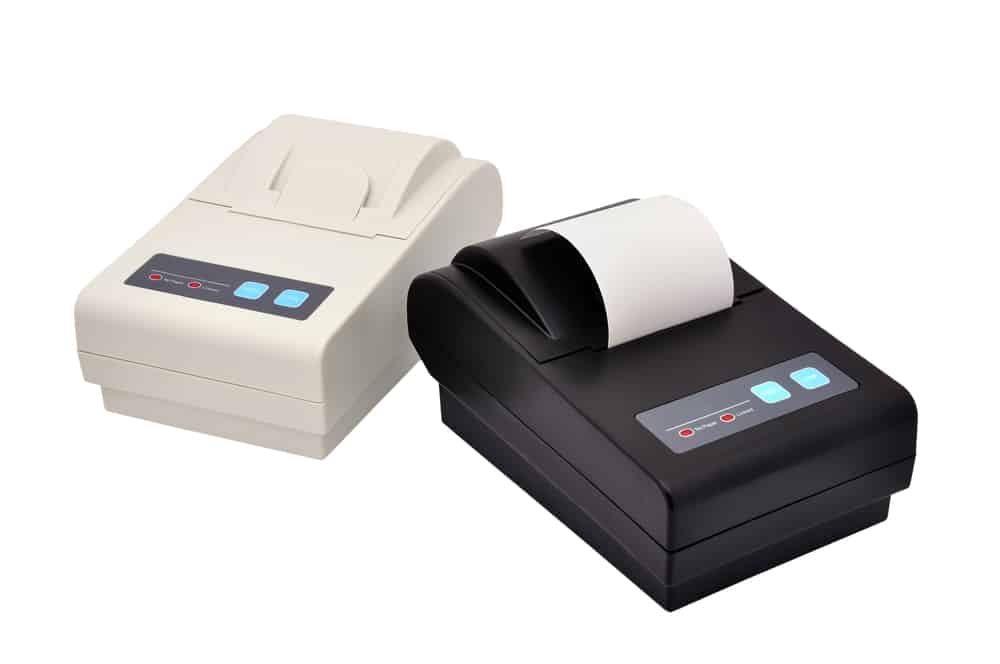This post may contain affiliate links, which means that we get commissions for purchases made through such links, at no additional cost to you. As an Amazon Associate we earn from qualifying purchases.
In this article, we present to you our findings on the uses of thermal printers. When we started hearing about thermal printers, we wondered what they were used for. Our team tried to find out and discovered that many people had little to no information about thermal printers. We later did an independent study to find out all the uses of thermal printers. Here are our findings
What are thermal printers used for? Thermal printers are used to print labels, tags, and stickers. These include items like receipts, shipping barcodes, and wristbands, among others. Using thermal printers is an inexpensive printing solution for many businesses. More so, they are easy to operate and work silently.
Thermal printers are of two varieties: direct thermal and thermal transfer. Each variety has its peculiar uses. So if you only know the general things you can do with thermal printers, your knowledge is not complete. As you read on, we will explain the two types of thermal printers, how they work, where they differ, and what you can do with them.

Which Facilities Use Thermal Printers?
Facilities that use thermal printers include transportation services, hospitals, lotter facilities, grocery stores, and libraries. Nowadays, you can find thermal printers almost everywhere.
When you withdraw money from an ATM, you’ll get a transaction receipt. These machines use thermal printing to generate their receipts. This is one of many other examples. Even music producers and filmmakers now use thermal CD printers to create permanent prints on thermal printable discs.
A few other examples of common industries that have embraced thermal printing are listed below. If you operate in any of these industries, you should consider using thermal printers:
Transportation Services
Transport services, including buses, airlines, shipping lines, and trains now use thermal printing. They often generate tickets or boarding passes using thermal technology. This method makes prints faster than regular printers. If they were to use a different printing method, there would be a long queue of people waiting for long hours for tickets and boarding passes to be issued before they could board.
Betting and Lottery
Betting and lottery agencies also issue tickets with thermal printing. Lottery tickets require fast printing so that the participants can proceed quickly to play their lottery. The same applies to betting agencies.
Hospitals
Doctors now use thermal printers for issuing drug prescriptions rather than write them manually. This eliminates the problem of illegible handwriting when the pharmacist wants to dispense the drugs. Thermal print prescriptions are clear and bold, so the pharmacist will have no problem reading them.
Aside from drug prescriptions, electrocardiograms (ECH) and ultrasound results are printed using thermal technology. These results present clear diagrams and figures which are easier to read and interpret.
More so, hospitals use barcode wristbands for both staff and patient identification. And when you pay for hospital services, they issue thermal receipts as proof of your transaction.
Grocery Stores and Supermarkets
You can hardly find any grocery store or supermarket these days that doesn’t use thermal printers. The cash registers and weighing scales at these stores print out thermal receipts. This method is faster than writing with a pen or using a regular printer. If you run a grocery store or supermarket, you should consider buying a thermal POS printer.
Libraries
Libraries are also using thermal printing to label their books. It is accurate, efficient, and affordable. They also print tags with thermal printers.
What Are The Uses of Direct Thermal vs. Thermal Transfer?
The typical uses of direct thermal printers are for basic, short-term printing applications. Conversely, The typical uses of thermal transfer printers are for long-lasting labels that can hold up to sunlight exposure and withstand abrasion, heat, moisture, and chemicals.
What Are Direct Thermal Printers Used For?
The typical uses of direct thermal printers are for basic, short-term printing applications. These include shipping labels, tickets, and receipts. It’s the common type that you will find in various machines that issue transaction receipts, such as cash registers, POS machines, and ATMs. Their speed also makes them suitable for industries.
What Are Thermal Transfer Printers Used For?
The typical uses of thermal transfer printers are for long-lasting labels that can hold up to sunlight exposure and withstand abrasion, heat, moisture, and chemicals. A few examples of thermal transfer applications include barcodes, product labels, asset tags, packaging labels, and clothing tags.
Thermal transfer printers are fast and produce durable images. However, various label types require different ribbon types. So you must match labels with the appropriate ribbon to achieve the best image quality.
How Direct Thermal Printers Work?
Direct thermal printers do not require toners, ink cartridges, or ribbon. They create images with direct heat on specialty media, called direct thermal papers. The printing machine draws thermal label rolls across the thermal printhead elements. As the paper runs through, it turns dark in the areas where heat is applied while other points remain plain.
As you can see, the process doesn’t need ink or any other supply aside from the paper rolls. This makes the mechanism simple, easy, and cost-effective for small businesses. However, thermal labels have a shorter image life and usually fade with time.
You should only use the direct thermal method when your application only needs short-term scannability and durability. If you require archiving, or something that can withstand light, high temperatures, chemicals, or abrasion, you should not use direct thermal.
More so, direct thermal printers are suitable for applications that don’t need complex color-coding. They typically print in one color, which is usually black or blue. Some models, however, print in two colors using different heat levels to achieve different colors.
How Thermal Transfer Printers Work?
Thermal transfer printers use ribbons to make durable and long-lasting images on thermal transfer labels. The heat from their printhead elements melts ink from the ribbon onto print materials as they run through the printer. You must match label materials with their appropriate ribbon type to get the best quality.
Thermal transfer printers can print in color but the options are still limited. Different ribbon colors are available but the printer can accept only one ribbon at a time. The color of the ribbon will determine the color of your print. However some new models of thermal transfer printers print hologram images with diverse color shades.
The Dye Sublimation Technique
A special type of thermal transfer printers uses the dye sublimation technique. Some embossing label makers use this special technique. This technique uses ribbons that contain four ink panels. Three of these panels bear primary colors while the fourth is clear.
How does the dye sublimation technique work? The heat from the thermal printhead causes the sublimation of solid ink, meaning that it turns solid ink straight to gas. In gas form, the ink permeates the paper on the exact spot and binds permanently to it. This makes the print very durable.
The dye sublimation technique produces long-lasting photo images with a full range of colors. The primary colors mix in the right proportions to create other colors as needed for the image.
✅ Video – Thermal Printers – CompTIA A+ 220-1001 – 3.11
This is one of Professor Messer’s free course materials on print technologies. It explains the two types of thermal printers, their uses, advantages, and disadvantages. You will learn a lot from this short video.
Advantages and Disadvantages of Using Thermal Printers
Thermal printers are versatile and require less maintenance. They can meet diverse printing needs. And since they have fewer moving parts, they are more reliable wand don’t need much maintenance. But then, their supplies are quite expensive and they have color limitations.
The advantages and disadvantages below are common to both types of thermal printers.
Advantages of Using Thermal Printers
Thermal printers are worth the investment. Your facility or office should be using thermal printers for the following reasons:
They Are Versatile
You can use thermal printers to print various items, including documents, signs, stickers, and labels. However, thermal transfer printers are more versatile than direct thermal printers. They can meet a vast array of printing needs, such as flash labels and floor markings, among others.
They Require Less Maintenance
Thermal printers typically have fewer parts to move around. They use neither ink cartridges nor toners, so they are easy to maintain and often last longer than regular printers. They are also more reliable because you never have to bother about running out of ink in the middle of a printing order.
Disadvantages of Using Thermal Printers
While thermal printers have lots of advantages, they also have a few drawbacks. Some of these drawbacks are as follows:
Cost of Supplies
Thermal printers use specialty materials, which cost more on the market than regular supplies. Thermal papers, for instance, cost more than regular papers. More so, the printers are also quite expensive. However, the cost of supplies might even out when you consider the cost of ink cartridges, which you wouldn’t have to buy when using thermal technology.
Color Limitations
This is the major drawback of thermal printing. They have fewer color options than regular printers. Because of their color limitations, thermal printers are not the best if you are printing high-quality photos.
Related Questions
What Is The Difference Between Inkjet And Thermal Printers?
Inkjet printers spray liquid ink droplets to make imprints on regular printing papers but thermal printers apply heat to create imprints. Direct thermal printers apply heat to activate ink pigments in thermal labels. Thermal transfer printers, on the other hand, use heat to melt dry pigment on the paper to create imprints.
Thermal printers work faster than inkjet printers. More so, thermal papers use specialty papers while inkjet papers can print on regular papers.
What Is The Difference Between Laser And Thermal Printers?
Laser printers infuse heat on papers while they go through the rollers but they still use toner cartridges. Thermal printers use only heat and ribbon; they don’t require toner or ink. More so thermal printers have a shorter path that laser printers and they use special thermal transfer papers.
There are special labels for laser printers, because of the measure of heat they work with. That’s why they cannot print on vinyl materials. Thermal transfer printers, on the other hand, can print on synthetic media including vinyl.
Is Thermal Paper Toxic?
Thermal papers are toxic because they contain BPA (bisphenol A), which is a hormone disruptor. Many producers of thermal papers have stopped adding BPA because of its toxicity. But most of them replaced it with BPS, which is closely related to BPA and also quite toxic.
Consumers must be aware that handling thermal papers (including receipts) might be risky health-wise. But the risks are minimal if you have limited contact with thermal papers. Vendors that work with them all day long stand the greatest risk.
Conclusion
Thermal printers have many uses that cut across diverse industries. However you must understand the differences between thermal printers and thermal transfer printers. They are similar but they have different uses and functionalities. To get the best print quality, you must match the printing technology, label type, and ribbon type (in case of thermal transfer printers) correctly.
